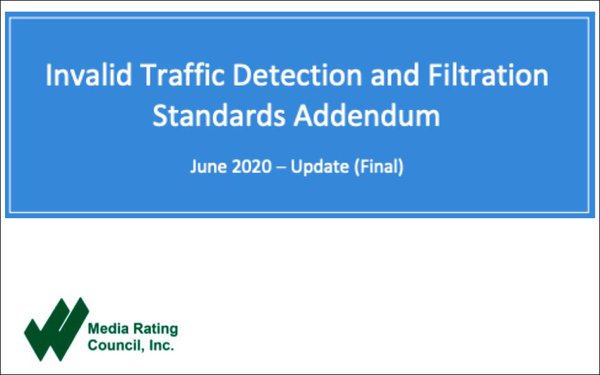
The Media Rating Council (MRC) this morning officially released
new standards intended to “modernize” how the advertising and media industry manage a key component of digital ad fraud: so-called “invalid traffic,” or IVT.
The update is an addendum to the MRC’s “Invalid Traffic Detection and Filtration
Guidelines,” which were originally issued nearly five years ago, to account for new forms of fraudulent traffic threats that did not exist when the original guidelines were
created.
The MRC said it established a regular process for updating its IVT standards, because it recognized that ad fraud is like a continuous arms race of innovation by
fraudulent sources and detection and adoption by the ad industry, but today’s update is the first time it has issued a comprehensive overhaul superseding “all previous
updates.”
advertisement
advertisement
The updated standards will also be applied to any measurement services applying for first-time MRC accreditation or for continuing accreditation, but the MRC
said currently accredited services will have a “one-year grace period, beginning today” to become fully compliant with the updated standards.
While the guidelines are
highly technical, they essentially set an industry standard for determining if and when digital traffic used as the basis for ad impressions is non-human and illegitimate, often because of some
devious technology such as spiders, bots or another mechanism is used to fraudulently represent real people.
Some of the key revisions included in the updated standards
include:
The addition of more specific Sophisticated Invalid Traffic (SIVT) areas.
The addition and updating of previous interim guidance on data center traffic requirements.
The addition of specific
requirements on risk assessment by platform and relevant traffic segment, as well as a requirement to directly link these to specific controls for each.
New requirements to disclose a “decision rate” metric (defined as the percentage of all impressions intended for measurement where sufficient information was obtained
to make a valid or invalid decision), along with definitions, calculations and requirements for supporting partial detection decisions.
The
addition and updating of previous interim guidance on requirements and disclosures associated with sampling approaches to IVT detection and filtration.
New requirements for the treatment and disclosure of purchased and acquired traffic.
The formalization of requirements,
previously documented in MRC’s Brand Safety Supplement, for the use of Machine Learning and Human Intervention in IVT detection practices.
The addition and updating of previous interim guidance on up-front filtration requirements.
The addition and updating
of previous interim guidance on mobile in-app requirements and added OTT-specific considerations.
The addition of guidance and requirements
for logged-in and subscription-based environments.
New detailed IVT discrepancy resolution procedures and requirements.